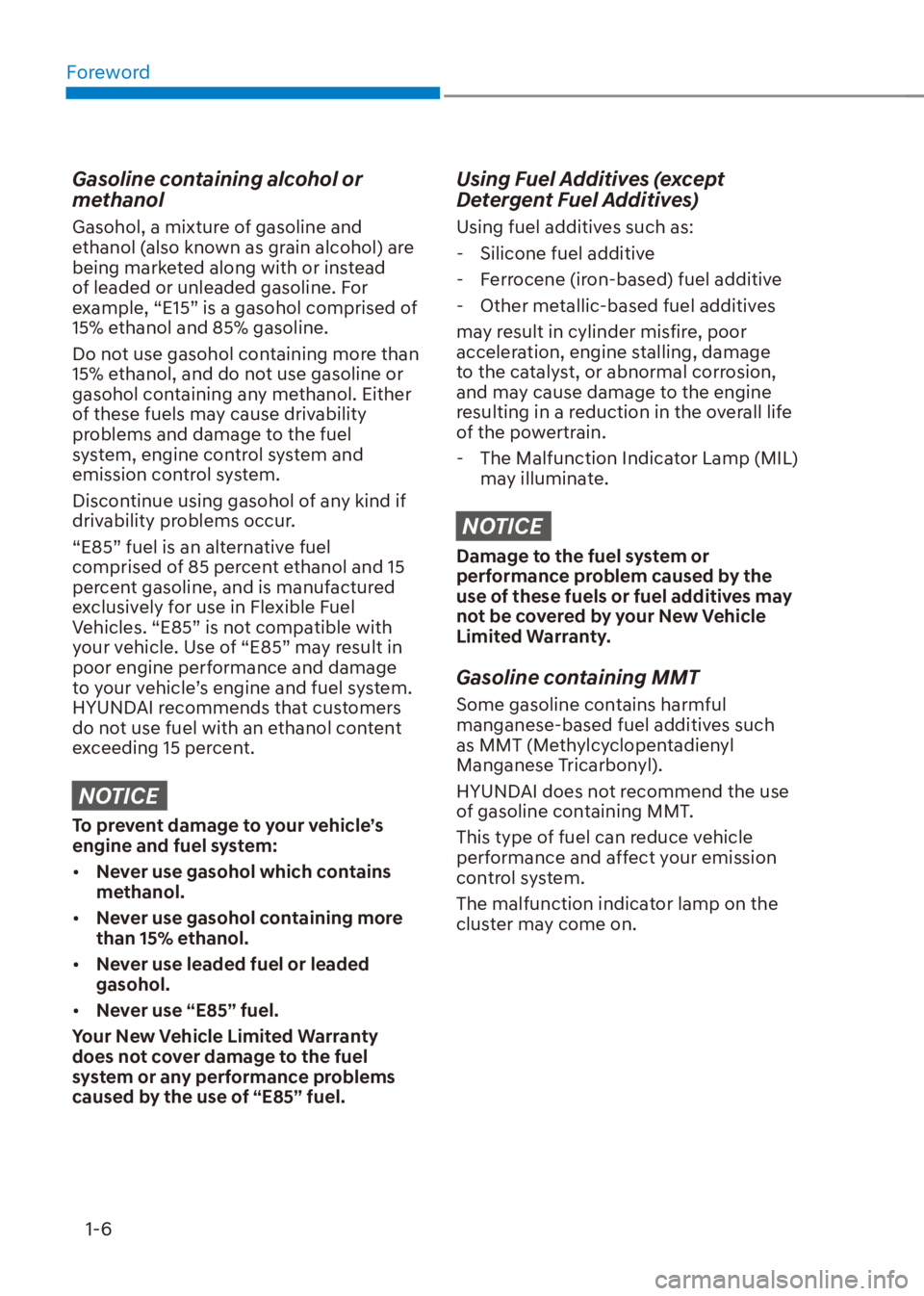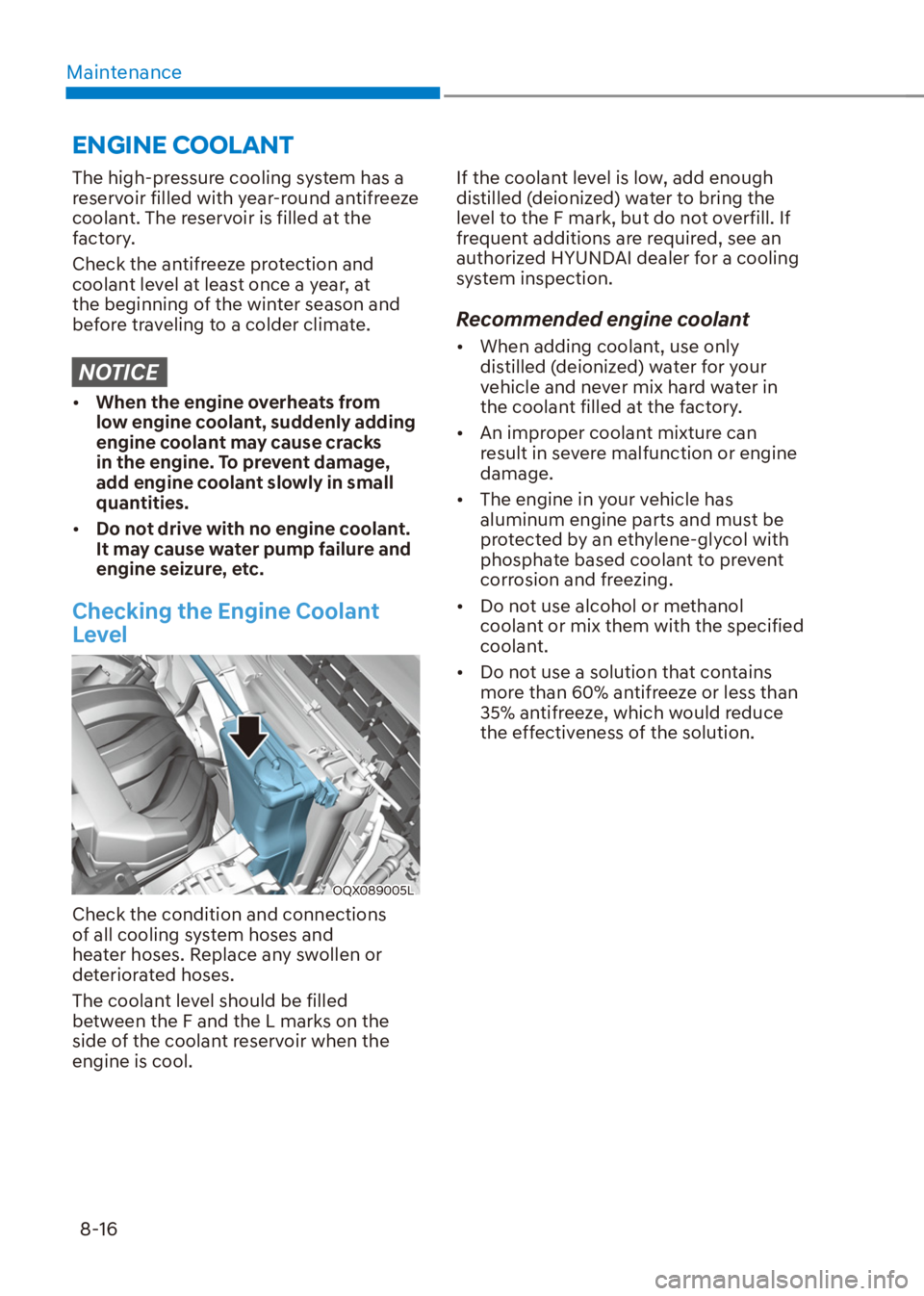Page 10 of 392

01
1-5
Your new vehicle is designed to obtain
maximum performance with UNLEADED
FUEL, as well as minimize exhaust
emissions and spark plug fouling.
Your new vehicle is designed to use only
unleaded fuel having an octane number
((R+M)/2) of 87 (Research Octane
Number 91) or higher. (Do not use
methanol blended fuels)
NOTICE
To prevent damage to the engine and
engine components, never add any fuel
system cleaning agents to the fuel tank
other than what has been specified.
Consult an authorized HYUNDAI dealer
for additional information.
WARNING
�[��Do not “top off” after the nozzle
automatically shuts off when
refueling.
�[��Always check that the fuel cap is
installed securely to prevent fuel
spillage in the event of an accident.
FUEL REQUIREMENTS
Throughout this manual DANGER,
WARNING, CAUTION, NOTICE and the
SAFETY ALERT SYMBOL will be used.
This is the safety alert symbol. It
is used to alert you to potential
physical injury hazards. Obey
all safety messages that follow
this symbol to avoid possible
injury or death. The safety alert
symbol precedes the signal
words DANGER, WARNING and
CAUTION.
DANGER
DANGER indicates a hazardous
situation which, if not avoided, will
result in death or serious injury.
WARNING
WARNING indicates a hazardous
situation which, if not avoided, could
result in death or serious injury.
CAUTION
CAUTION indicates a hazardous
situation which, if not avoided, could
result in minor or moderate injury.
NOTICE
NOTICE indicates a situation which,
if not avoided, could result in vehicle
damage.
Page 11 of 392

Foreword
1-6
Gasoline containing alcohol or
methanol
Gasohol, a mixture of gasoline and
ethanol (also known as grain alcohol) are
being marketed along with or instead
of leaded or unleaded gasoline. For
example, “E15” is a gasohol comprised of
15% ethanol and 85% gasoline.
Do not use gasohol containing more than
15% ethanol, and do not use gasoline or
gasohol containing any methanol. Either
of these fuels may cause drivability
problems and damage to the fuel
system, engine control system and
emission control system.
Discontinue using gasohol of any kind if
drivability problems occur.
“E85” fuel is an alternative fuel
comprised of 85 percent ethanol and 15
percent gasoline, and is manufactured
exclusively for use in Flexible Fuel
Vehicles. “E85” is not compatible with
your vehicle. Use of “E85” may result in
poor engine performance and damage
to your vehicle’s engine and fuel system.
HYUNDAI recommends that customers
do not use fuel with an ethanol content
exceeding 15 percent.
NOTICE
To prevent damage to your vehicle’s
engine and fuel system:
�[��Never use gasohol which contains
methanol.
�[��Never use gasohol containing more
than 15% ethanol.
�[��Never use leaded fuel or leaded
gasohol.
�[��Never use “E85” fuel.
Your New Vehicle Limited Warranty
does not cover damage to the fuel
system or any performance problems
caused by the use of “E85” fuel.
Using Fuel Additives (except
Detergent Fuel Additives)
Using fuel additives such as:
- Silicone fuel additive
- Ferrocene (iron-based) fuel additive
- Other metallic-based fuel additives
may result in cylinder misfire, poor
acceleration, engine stalling, damage
to the catalyst, or abnormal corrosion,
and may cause damage to the engine
resulting in a reduction in the overall life
of the powertrain.
- The Malfunction Indicator Lamp (MIL)
may illuminate.
NOTICE
Damage to the fuel system or
performance problem caused by the
use of these fuels or fuel additives may
not be covered by your New Vehicle
Limited Warranty.
Gasoline containing MMT
Some gasoline contains harmful
manganese-based fuel additives such
as MMT (Methylcyclopentadienyl
Manganese Tricarbonyl).
HYUNDAI does not recommend the use
of gasoline containing MMT.
This type of fuel can reduce vehicle
performance and affect your emission
control system.
The malfunction indicator lamp on the
cluster may come on.
Page 323 of 392

Maintenance
8-16
The high-pressure cooling system has a
reservoir filled with year-round antifreeze
coolant. The reservoir is filled at the
factory.
Check the antifreeze protection and
coolant level at least once a year, at
the beginning of the winter season and
before traveling to a colder climate.
NOTICE
�[��When the engine overheats from
low engine coolant, suddenly adding
engine coolant may cause cracks
in the engine. To prevent damage,
add engine coolant slowly in small
quantities.
�[��Do not drive with no engine coolant.
It may cause water pump failure and
engine seizure, etc.
Checking the Engine Coolant
Level
OQX089005L
Check the condition and connections
of all cooling system hoses and
heater hoses. Replace any swollen or
deteriorated hoses.
The coolant level should be filled
between the F and the L marks on the
side of the coolant reservoir when the
engine is cool.If the coolant level is low, add enough
distilled (deionized) water to bring the
level to the F mark, but do not overfill. If
frequent additions are required, see an
authorized HYUNDAI dealer for a cooling
system inspection.
Recommended engine coolant
�[��When adding coolant, use only
distilled (deionized) water for your
vehicle and never mix hard water in
the coolant filled at the factory.
�[��An improper coolant mixture can
result in severe malfunction or engine
damage.
�[��The engine in your vehicle has
aluminum engine parts and must be
protected by an ethylene-glycol with
phosphate based coolant to prevent
corrosion and freezing.
�[��Do not use alcohol or methanol
coolant or mix them with the specified
coolant.
�[��Do not use a solution that contains
more than 60% antifreeze or less than
35% antifreeze, which would reduce
the effectiveness of the solution.
ENGINE COOLANT